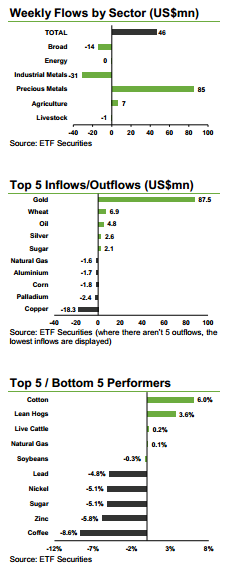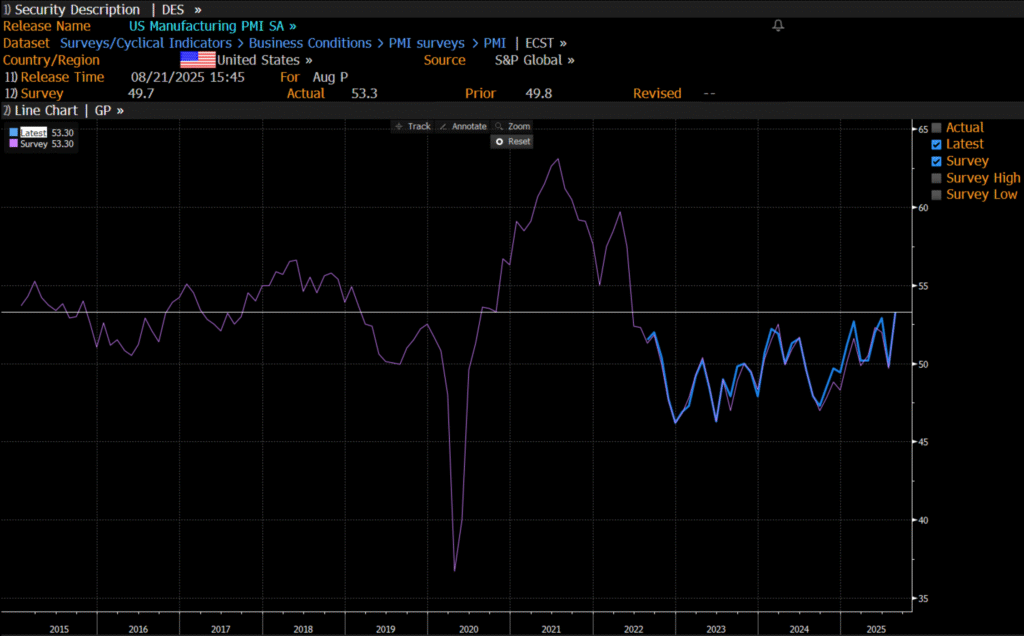Analys
Oil and gold remain top trades as bargain hunting drives flows

 Gold and oil ETPs both respectively saw their 9th consecutive week of inflows. The price of gold and oil has fallen in recent weeks, in part reflecting a reduction in the geopolitical premium following a ceasefire agreed by Ukraine and Russia. Bargain hunting investors have chosen to increase their holdings of oil with its price looking particularly attractive, with both Brent and WTI oil benchmarks trading below US$100/bbl. We believe OPEC is likely to cut production if demand for oil continues to remain weak, which will in turn help support prices. Despite weakness in gold prices, investors have generally maintained holdings over the past few months. Daily flow data however indicates that some investors are losing patience with gold in recent days and its weak price could test the endurance of some investors if the relatively stable geopolitical situation lasts.
Gold and oil ETPs both respectively saw their 9th consecutive week of inflows. The price of gold and oil has fallen in recent weeks, in part reflecting a reduction in the geopolitical premium following a ceasefire agreed by Ukraine and Russia. Bargain hunting investors have chosen to increase their holdings of oil with its price looking particularly attractive, with both Brent and WTI oil benchmarks trading below US$100/bbl. We believe OPEC is likely to cut production if demand for oil continues to remain weak, which will in turn help support prices. Despite weakness in gold prices, investors have generally maintained holdings over the past few months. Daily flow data however indicates that some investors are losing patience with gold in recent days and its weak price could test the endurance of some investors if the relatively stable geopolitical situation lasts.
 Bargain hunting drove US$7.4mn into long oil ETPs, marking the longest stretch of weekly inflows since 2012. Although bets weren’t completely one-sided, with US$2.7mn of inflows into short oil ETPs, many investors are doubtful that the current weakness in oil price can persist. Weak global demand for oil products this summer, combined with the limited impact of geopolitical risks on OPEC and Russian oil supply sent both Brent and WTI prices to multi-month lows. With production reaching multi-decade highs, US oil inventories had remained above its 5-year range until very recently and stockpiles at Cushing have been slowly rebuilding. While Chinese oil imports and the US summer driving season have not been as supportive of oil demand as expected, the US Energy Information Agency (EIA) is forecasting a supply deficit for the second half of 2014 and OPEC is anticipating a pick-up in global oil demand during the remaining months of 2014. Should that pick-up in demand not materialise, we believe that OPEC will cut production from its current target of 30mb/d.
Bargain hunting drove US$7.4mn into long oil ETPs, marking the longest stretch of weekly inflows since 2012. Although bets weren’t completely one-sided, with US$2.7mn of inflows into short oil ETPs, many investors are doubtful that the current weakness in oil price can persist. Weak global demand for oil products this summer, combined with the limited impact of geopolitical risks on OPEC and Russian oil supply sent both Brent and WTI prices to multi-month lows. With production reaching multi-decade highs, US oil inventories had remained above its 5-year range until very recently and stockpiles at Cushing have been slowly rebuilding. While Chinese oil imports and the US summer driving season have not been as supportive of oil demand as expected, the US Energy Information Agency (EIA) is forecasting a supply deficit for the second half of 2014 and OPEC is anticipating a pick-up in global oil demand during the remaining months of 2014. Should that pick-up in demand not materialise, we believe that OPEC will cut production from its current target of 30mb/d.
Long wheat ETPs saw their 17th consecutive week of inflows as investors mounted bets on a less bearish USDA report. After months of successive production and stock upgrades, some investors thought that last Thursday’s World Agricultural Demand and Supply Estimate report would show some stabilisation. It turns out that they were disappointed. The price of wheat fell 4.2% last week alone and is now trading at the lowest level since 2010. With wheat priced for perfect growing conditions, any small hiccup in weather in major producing countries or an escalation in trade restrictions could drive a price rally. More bargain hunting is likely with prices at multi-year low levels.
Concern over China and supply prompted another week of outflows in industrial metal ETPs, marking the largest cumulative four week outflow since May 2013. Last week, US$9.1mn was redeemed from ETFS Industrial Metals (AIGI) basket and most long industrial metal ETPs saw outflows. Long copper ETPs in particular saw US$18.6mn of outflows. Industrial metal prices declined as jitters over the health of Chinese demand troubled investors and the probability of the Philippines following Indonesia’s lead in banning ore exports has lessened. By the end of the week, however, China reported strong credit growth for the past month, which should go a long way to ease concerns about its ability to drive demand for commodity-intensive house building and infrastructure construction.
Key events to watch this week. The Federal Reserve’s FOMC meeting will be the focus of market attention. The US central bank is expected to continue to taper its bond-buying programme at the current rate, which will only leave another meeting (after this week’s) before it announces a stop to more purchases. After a disappointing US payrolls report, the market will watch out for any changes in forward guidance that could signal rate changes slower than current market expectations.
Analys
OPEC+ in a process of retaking market share

Oil prices are likely to fall for a fourth straight year as OPEC+ unwinds cuts and retakes market share. We expect Brent crude to average USD 55/b in Q4/25 before OPEC+ steps in to stabilise the market into 2026. Surplus, stock building, oil prices are under pressure with OPEC+ calling the shots as to how rough it wants to play it. We see natural gas prices following parity with oil (except for seasonality) until LNG surplus arrives in late 2026/early 2027.

Oil market: Q4/25 and 2026 will be all about how OPEC+ chooses to play it
OPEC+ is in a process of unwinding voluntary cuts by a sub-group of the members and taking back market share. But the process looks set to be different from 2014-16, as the group doesn’t look likely to blindly lift production to take back market share. The group has stated very explicitly that it can just as well cut production as increase it ahead. While the oil price is unlikely to drop as violently and lasting as in 2014-16, it will likely fall further before the group steps in with fresh cuts to stabilise the price. We expect Brent to fall to USD 55/b in Q4/25 before the group steps in with fresh cuts at the end of the year.

Natural gas market: Winter risk ahead, yet LNG balance to loosen from 2026
The global gas market entered 2025 in a fragile state of balance. European reliance on LNG remains high, with Russian pipeline flows limited to Turkey and Russian LNG constrained by sanctions. Planned NCS maintenance in late summer could trim exports by up to 1.3 TWh/day, pressuring EU storage ahead of winter. Meanwhile, NE Asia accounts for more than 50% of global LNG demand, with China alone nearing a 20% share (~80 mt in 2024). US shale gas production has likely peaked after reaching 104.8 bcf/d, even as LNG export capacity expands rapidly, tightening the US balance. Global supply additions are limited until late 2026, when major US, Qatari and Canadian projects are due to start up. Until then, we expect TTF to average EUR 38/MWh through 2025, before easing as the new supply wave likely arrives in late 2026 and then in 2027.
Analys
Manufacturing PMIs ticking higher lends support to both copper and oil

Price action contained withing USD 2/b last week. Likely muted today as well with US closed. The Brent November contract is the new front-month contract as of today. It traded in a range of USD 66.37-68.49/b and closed the week up a mere 0.4% at USD 67.48/b. US oil inventory data didn’t make much of an impact on the Brent price last week as it is totally normal for US crude stocks to decline 2.4 mb/d this time of year as data showed. This morning Brent is up a meager 0.5% to USD 67.8/b. It is US Labor day today with US markets closed. Today’s price action is likely going to be muted due to that.

Improving manufacturing readings. China’s manufacturing PMI for August came in at 49.4 versus 49.3 for July. A marginal improvement. The total PMI index ticked up to 50.5 from 50.2 with non-manufacturing also helping it higher. The HCOB Eurozone manufacturing PMI was a disastrous 45.1 last December, but has since then been on a one-way street upwards to its current 50.5 for August. The S&P US manufacturing index jumped to 53.3 in August which was the highest since 2022 (US ISM manufacturing tomorrow). India manufacturing PMI rose further and to 59.3 for August which is the highest since at least 2022.
Are we in for global manufacturing expansion? Would help to explain copper at 10k and resilient oil. JPMorgan global manufacturing index for August is due tomorrow. It was 49.7 in July and has been below the 50-line since February. Looking at the above it looks like a good chance for moving into positive territory for global manufacturing. A copper price of USD 9935/ton, sniffing at the 10k line could be a reflection of that. An oil price holding up fairly well at close to USD 68/b despite the fact that oil balances for Q4-25 and 2026 looks bloated could be another reflection that global manufacturing may be accelerating.
US manufacturing PMI by S&P rose to 53.3 in August. It was published on 21 August, so not at all newly released. But the US ISM manufacturing PMI is due tomorrow and has the potential to follow suite with a strong manufacturing reading.

Analys
Crude stocks fall again – diesel tightness persists

U.S. commercial crude inventories posted another draw last week, falling by 2.4 million barrels to 418.3 million barrels, according to the latest DOE report. Inventories are now 6% below the five-year seasonal average, underlining a persistently tight supply picture as we move into the post-peak demand season.

While the draw was smaller than last week’s 6 million barrel decline, the trend remains consistent with seasonal patterns. Current inventories are still well below the 2015–2022 average of around 449 million barrels.
Gasoline inventories dropped by 1.2 million barrels and are now close to the five-year average. The breakdown showed a modest increase in finished gasoline offset by a decline in blending components – hinting at steady end-user demand.
Diesel inventories saw yet another sharp move, falling by 1.8 million barrels. Stocks are now 15% below the five-year average, pointing to sustained tightness in middle distillates. In fact, diesel remains the most undersupplied segment, with current inventory levels at the very low end of the historical range (see page 3 attached).
Total commercial petroleum inventories – including crude and products but excluding the SPR – fell by 4.4 million barrels on the week, bringing total inventories to approximately 1,259 million barrels. Despite rising refinery utilization at 94.6%, the broader inventory complex remains structurally tight.
On the demand side, the DOE’s ‘products supplied’ metric – a proxy for implied consumption – stayed strong. Total product demand averaged 21.2 million barrels per day over the last four weeks, up 2.5% YoY. Diesel and jet fuel were the standouts, up 7.7% and 1.7%, respectively, while gasoline demand softened slightly, down 1.1% YoY. The figures reflect a still-solid late-summer demand environment, particularly in industrial and freight-related sectors.


-

 Nyheter3 veckor sedan
Nyheter3 veckor sedanOmgående mångmiljardfiasko för Equinors satsning på Ørsted och vindkraft
-

 Nyheter4 veckor sedan
Nyheter4 veckor sedanLundin Gold hittar ny koppar-guld-fyndighet vid Fruta del Norte-gruvan
-

 Nyheter2 veckor sedan
Nyheter2 veckor sedanMeta bygger ett AI-datacenter på 5 GW och 2,25 GW gaskraftverk
-

 Nyheter4 veckor sedan
Nyheter4 veckor sedanGuld stiger till över 3500 USD på osäkerhet i världen
-

 Analys3 veckor sedan
Analys3 veckor sedanWhat OPEC+ is doing, what it is saying and what we are hearing
-

 Nyheter4 veckor sedan
Nyheter4 veckor sedanAlkane Resources och Mandalay Resources har gått samman, aktör inom guld och antimon
-

 Nyheter2 veckor sedan
Nyheter2 veckor sedanAker BP gör ett av Norges största oljefynd på ett decennium, stärker resurserna i Yggdrasilområdet
-

 Nyheter4 veckor sedan
Nyheter4 veckor sedanLyten, tillverkare av litium-svavelbatterier, tar över Northvolts tillgångar i Sverige och Tyskland







